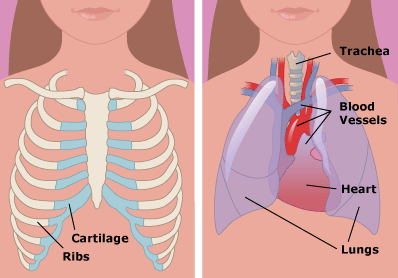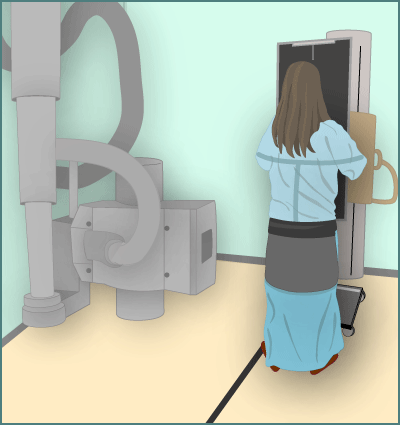Can You Get a Chest X Ray at Urgent Care
What It Is
A chest X-ray is a safe and painless test that uses a small amount of radiation to take a picture of a person's chest. During the examination, an X-ray machine sends a beam of radiation through the chest, and an image is recorded on special film or a computer.
This image includes organs and structures such as the heart, lungs, large blood vessels, diaphragm, part of the airway, lymph nodes, the upper spine, ribs, collarbone, and breastbone.

The X-ray image is black and white. Dense body parts that block the passage of the X-ray beam through the body, such as the heart and bones, appear white on the X-ray image. Hollow body parts, such as the lungs, allow X-ray beams to pass through them and appear black.
An X-ray technician takes the X-rays. Usually, two are taken: one from the back of the chest if the child is old enough to stand up for the X-ray, and one from the side. In younger children a picture from the front of the chest is taken as well as from the side. In some cases, special views of the chest are taken.
Page 1
Why It's Done
A chest X-ray is used to help find the cause of symptoms such as cough, shortness of breath, or chest pain. It can detect signs of asthma, pneumonia, a collapsed lung, heart problems (such as an enlarged heart), and broken ribs or lung damage after an injury.
Chest X-rays can reveal small metal objects (such as coins) that might have been swallowed. They can also help confirm that medical tubes have been placed in the right locations in the lungs, heart, blood vessels, or stomach.
Preparation
A chest X-ray doesn't require special preparation. Your child may be asked to remove all clothing and jewelry from the waist up and change into a hospital gown because buttons, zippers, clasps, or jewelry might interfere with the image.
Developing babies are more sensitive to radiation and are at more risk for harm, so if your daughter is pregnant, tell her doctor and the X-ray technician.
Procedure
Although the procedure may take 15 minutes or longer from start to finish, the actual exposure time to radiation is usually less than half a second.
Your child will be asked to enter a special room that will most likely contain a table and a large X-ray machine hanging from the ceiling. Parents are usually able to accompany their child to provide reassurance and support.
A chest X-ray may be performed in a standing, sitting, or lying position. This will depend on the condition of your child and the reason for the X-ray. The technician will position your child, then step behind a wall or to an adjoining room to operate the machine.
Older kids will be asked to hold their breath and remain still for 2-3 seconds while the X-ray is taken; infants may require gentle restraint. Keeping the chest still is important to prevent blurring of the X-ray image. Two X-rays are usually taken, one from the back and one from the side.

If your child is in the hospital and cannot easily be brought to the radiology department, a portable X-ray machine can be brought to your child's bedside. Portable X-rays are often used in emergency departments, intensive care units, or operating rooms. In this case, only one X-ray might be taken, usually from the front.
Page 2
What to Expect
Your child won't feel anything as the X-ray is taken. The X-ray room may feel cool due to air conditioning used to maintain the equipment.
Positions required for the X-ray may feel uncomfortable, but they need to be held for only a few seconds. If your child has an injury and cannot stay in the required position, the technician might be able to find another position that's easier on your child. Babies often cry in the X-ray room, especially if they're restrained, but this won't interfere with the procedure.
If you stay in the room while the X-ray is being done, you'll be asked to wear a lead apron to protect certain parts of your body. Your child's reproductive organs will also be protected with a lead shield.
After the X-rays are taken, you and your child will be asked to wait a few minutes while the images are processed. If they are blurred or unclear, the X-rays may need to be redone.
Getting the Results
The X-rays will be looked at by a radiologist (a doctor who is specially trained in reading and interpreting X-ray images). The radiologist will send a report to your child's doctor, who will discuss the results with you and explain what they mean.
In an emergency, the results of a chest X-ray can be available within a short period of time. Otherwise, results are usually ready in 1 or 2 days. In most cases, results cannot be given directly to the patient or family at the time of the test.
Risks
In general, chest X-rays are very safe. Although any exposure to radiation poses some risk to the body, the amount used in a chest X-ray is small and not considered dangerous. It's important to know that radiologists use the minimum amount of radiation required to get the best results.
Developing babies are more sensitive to radiation and are at greater risk for harm, so if your daughter is pregnant, make sure to inform her doctor and the X-ray technician.
Helping Your Child
You can help your young child prepare for a chest X-ray by explaining the test in simple terms before the procedure. It may help to explain that getting an X-ray is much like posing for a picture. You can describe the room and the equipment that will be used, and reassure your child that you'll be right there for support.
For older kids, be sure to explain the importance of keeping still while the X-ray is taken so it won't have to be repeated.
If You Have Questions
If you have questions about why the chest X-ray is needed, speak with the doctor. You can also talk to the X-ray technician before the procedure.
Can You Get a Chest X Ray at Urgent Care
Source: https://www.kidshealth.org/en/parents/xray-exam-chest.html